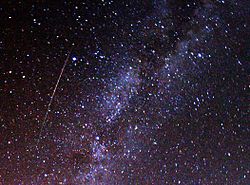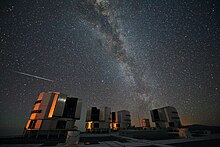Perseids
From Wikipedia, the free encyclopedia
For the mythological term, see Perseides. For the Mycenaean royal house, see Perseid dynasty.
| Perseids (PER) | |
|---|---|

A multicolored, long Perseid striking the sky just to the left of Milky Way, 2009
|
|
| Pronunciation | /ˈpɜrsiːɨdz/ |
| Discovery date | 36 AD (first record)[1][2] |
| Parent body | Swift-Tuttle[3] |
| Radiant | |
| Constellation | Perseus |
| Right ascension | 03h 04m[3] |
| Declination | +58°[3] |
| Properties | |
| Occurs during | July 23 – August 20[3] |
| Date of peak | August 13[3] |
| Velocity | 58[4] km/s |
| Zenithal hourly rate | 80[3] |
| See also: List of meteor showers | |
The stream of debris is called the Perseid cloud and stretches along the orbit of the comet Swift-Tuttle. The cloud consists of particles ejected by the comet as it travels on its 133-year orbit.[5] Most of the particles have been part of the cloud for around a thousand years. However, there is also a relatively young filament of dust in the stream that was pulled off the comet in 1865, which can give an early mini-peak the day before the maximum shower.[6]
The earliest information on this meteor shower is found in Chinese annals in A.D. 36. However, credit for recognising the shower's annual appearance is given to Adolphe Quetelet, who reported in 1835 that there was a shower emanating from the constellation Perseus.[1][2] Some Catholics refer to the Perseids as the "tears of St. Lawrence", since 10 August is the date of that saint's martyrdom.[7]
The shower is visible from mid-July each year, with the peak in activity between 9 and 14 August, depending on the particular location of the stream. During the peak, the rate of meteors reaches 60 or more per hour. They can be seen all across the sky; but, because of the path of Swift-Tuttle's orbit, Perseids are primarily visible in the northern hemisphere. As with many meteor showers, the visible rate is greatest in the pre-dawn hours, since the side of the Earth nearest to turning into the sun scoops up more meteors as the Earth moves through space. Most Perseids disappear while at heights above 80 kilometres (50 mi).[8]
SEE ALSO!

This comment has been removed by the author.
ReplyDeleteপৃথিবী স্থান মাধ্যমে প্যাচসমূহ হিসাবে সূর্য মধ্যে বাঁক কাছের পৃথিবীর দিকে আরো উল্কা scoops থেকে. সর্বাধিক Perseids অদৃশ্য হয়ে যখন উচ্চতা এ উপরে 80 কিলোমিটার (50 মাইল). [8]
ReplyDelete